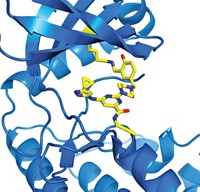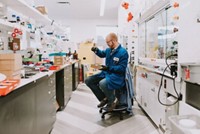Advertisement
Grab your lab coat. Let's get started
Welcome!
Welcome!
Create an account below to get 6 C&EN articles per month, receive newsletters and more - all free.
It seems this is your first time logging in online. Please enter the following information to continue.
As an ACS member you automatically get access to this site. All we need is few more details to create your reading experience.
Not you? Sign in with a different account.
Not you? Sign in with a different account.
ERROR 1
ERROR 1
ERROR 2
ERROR 2
ERROR 2
ERROR 2
ERROR 2
Password and Confirm password must match.
If you have an ACS member number, please enter it here so we can link this account to your membership. (optional)
ERROR 2
ACS values your privacy. By submitting your information, you are gaining access to C&EN and subscribing to our weekly newsletter. We use the information you provide to make your reading experience better, and we will never sell your data to third party members.
Pharmaceuticals
Chemical Biology: In Situ Click Chemistry
Technique morphs enzymes into screening tools for potential drugs and antibodies—but it’s still not perfected
by Carmen Drahl
December 24, 2012
| A version of this story appeared in
Volume 90, Issue 52
In 2002, chemists at Scripps Research Institute in California tricked the Alzheimer’s-linked enzyme acetylcholinesterase into making a powerful inhibitor of its own activity. It was a test case for streamlining drug design by involving the target as early as possible. They used a selective form of the cycloaddition reaction between azides and alkynes that’s better known as click chemistry (Angew. Chem. Int. Ed. 2002,41, 1053). And they used the enzyme target’s own shape constraints and noncovalent interactions as a molecular-scale reaction vessel.
The research team, led by K. Barry Sharpless and M. G. Finn, dubbed the technique in situ click chemistry. Researchers began to explore the method’s potential as a screen for drugs, light-harvesting compounds, and more. Ten years on, the technique has had some successes, but it hasn’t been widely adopted.
The method was a newcomer to the area of target-guided synthesis, which aims to streamline discovery of functional molecules by combining screening and synthesis into one process. The click approach has a few differences from other target-guided techniques, including minimal side reactions.
A handful of teams have carried the technique forward. In 2009, a UCLA lab developed a microfluidic platform to perform 1,024 in situ click reactions in parallel. Then in 2010, scientists at France’s National Institute of Health & Medical Research applied the technique to examine the protein EthR, a possible tuberculosis drug target.

Also in 2009, Caltech’s James R. Heath collaborated with the Scripps team to make agents that act like antibodies. Integrated Diagnostics, a company Heath cofounded, plans to develop the so-called protein-catalyzed capture agents into clinical diagnostic tools for diseases such as cancer.
“There’s no reason why our approach should be restricted to enzyme inhibitors,” Finn says. “That’s part of the reason why I rave about Heath’s work.”
A few pharmaceutical companies have tried the click technique. A team at Amgen explored it while hunting for tight-binding inhibitors of β-secretase, a potential Alzheimer’s drug target. In a 2007 meeting presentation, Amgen researchers praised the technique’s ability to account for the dynamic nature of the target proteins but noted that the click reaction is slow.
This click chemistry variant “certainly hasn’t taken the world by storm,” Finn says. “It is still a hit-or-miss proposition. No one’s taken the time to figure out what conditions make it work consistently.”
Compared with this work, Sharpless has garnered more citations for a copper(I) catalyzed version of click chemistry he also published in 2002 (Angew. Chem. Int. Ed. 2002,41, 2596). That paper is the fourth-most-cited work in chemistry from 2002, according to statistics from the American Chemical Society’s Chemical Abstracts Service.
Whether or not the click technique proves to be a panacea for molecular discovery, Sharpless says, chemists should keep searching for better screens. “Every year that goes by it becomes clearer that the intentional designing of inhibitors is very difficult, and luck plays a bigger role than we’d like,” he says. Even if established techniques tip the odds in chemists’ favor, Sharpless adds, they are far from cost-efficient.





Join the conversation
Contact the reporter
Submit a Letter to the Editor for publication
Engage with us on Twitter